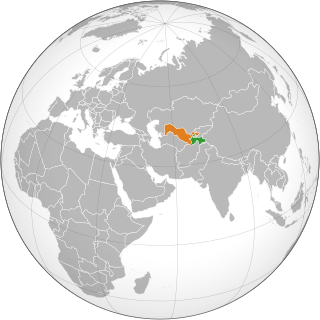| Total population | |
|---|---|
| Regions with significant populations | |
| Languages | |
| Religion | |
Tajik Americans are Americans who trace their origin to Tajikistan, or Samarkand and Bukhara region of Uzbekistan. The majority of Tajik Americans are ethnic Tajiks.
| Total population | |
|---|---|
| Regions with significant populations | |
| Languages | |
| Religion | |
Tajik Americans are Americans who trace their origin to Tajikistan, or Samarkand and Bukhara region of Uzbekistan. The majority of Tajik Americans are ethnic Tajiks.
About 6,000 Tajiks live in the US, although this number could be as high as 100,000 if you consider the Tajiks who migrated to the US as Uzbek nationals. Most reside in Brooklyn, Philadelphia, Chicago as well as in Washington, D.C. Many come to the U.S. to study and work. Most Tajiks who emigrated to work get the right of permanent residence. Most second-generation Tajiks can speak their original language, while those of mixed descent mainly speak English. Many marry other Tajiks because of their cultural affinity. [2]
Several Tajik associations operate in the U.S. One is the American-Tajik Association, established in Brooklyn, [3] whose goal is to unite the Tajik diaspora, giving them a forum to gather and celebrate their culture. [4]
In May 2012, the Tajik American Cultural Association (TACA) was founded by Tajik local volunteers Vladimir Fedorenko, Anvar Samadzoda, Akobir Akhmedov and Faridun Nazarov in Fairfax, Virginia as a non-profit, non-governmental, cultural, professional, and educational organization. The mission of TACA is to promote and facilitate intercultural understanding and cooperation by organizing educational and cultural programs that focus on issues concerning the Tajik American community. [5] In addition, TACA strives to address the needs of the Tajik community in America. TACA believes that building cultural bridges among Tajik and American communities is needed and aims to promote further integration, encourage cooperation and establish close relations with other US communities.

Central Asia is a subregion of Asia that stretches from the Caspian Sea in the southwest and Eastern Europe in the northwest to Western China and Mongolia in the east, and from Afghanistan and Iran in the south to Russia in the north. It includes the former Soviet republics of Kazakhstan, Kyrgyzstan, Tajikistan, Turkmenistan, and Uzbekistan. The countries as a group are also colloquially referred to as the "-stans" as all have names ending with the Persian suffix "-stan" in both respective native languages and most other languages.

Tajikistan, officially the Republic of Tajikistan, is a landlocked country in Central Asia. It has an area of 142,326 km2 (54,952 sq mi) and an estimated population of 9,750,065 people. Dushanbe is the country's capital and largest city. It is bordered by Afghanistan to the south, Uzbekistan to the west, Kyrgyzstan to the north, and China to the east. It is separated narrowly from Pakistan by Afghanistan's Wakhan Corridor. Tajiks form the ethnic majority in the country and their national language is Tajik, a variety of Persian that is closely related to the mutually intelligible dialects of Farsi and Dari in Iran and Afghanistan.

Tajiks are a Persian-speaking Iranian ethnic group native to Central Asia, living primarily in Afghanistan, Tajikistan, and Uzbekistan. Tajiks are the largest ethnicity in Tajikistan, and the second-largest in Afghanistan and Uzbekistan. They speak varieties of Persian, a Western Iranian language. In Tajikistan, since the 1939 Soviet census, its small Pamiri and Yaghnobi ethnic groups are included as Tajiks. In China, the term is used to refer to its Pamiri ethnic groups, the Tajiks of Xinjiang, who speak the Eastern Iranian Pamiri languages. In Afghanistan, the Pamiris are counted as a separate ethnic group.

Tajik, also called Tajiki Persian or Tajiki, is the variety of Persian spoken in Tajikistan and Uzbekistan by Tajiks. It is closely related to neighbouring Dari of Afghanistan with which it forms a continuum of mutually intelligible varieties of the Persian language. Several scholars consider Tajik as a dialectal variety of Persian rather than a language on its own. The popularity of this conception of Tajik as a variety of Persian was such that, during the period in which Tajik intellectuals were trying to establish Tajik as a language separate from Persian, prominent intellectual Sadriddin Ayni counterargued that Tajik was not a "bastardised dialect" of Persian. The issue of whether Tajik and Persian are to be considered two dialects of a single language or two discrete languages has political sides to it.

Bukharan Jews, in modern times also called Bukharian Jews, are an ethnoreligious Jewish sub-group of Central Asia that historically spoke Bukharian, a Judeo-Tajik dialect of the Tajik language, in turn a variety of the Persian language. Their name comes from the former Central Asian Emirate of Bukhara, which once had a sizable Jewish population. Bukharan Jews comprise Persian-speaking Jewry along with the Jews of Iran, Afghanistan, and the Caucasus Mountains. Bukharan Jews are Mizrahi Jews, like Persian, Afghan and Mountain Jews.

Bukharian is a Judeo-Persian dialect historically spoken by the Bukharan Jews of Central Asia. It is a Jewish dialect derived from — and largely mutually intelligible with — the Tajik branch of the Persian language.
Ethiopian Americans are Americans of Ethiopian descent, as well as individuals of American and Ethiopian ancestry. The largest Ethiopian American community is in the Washington, D.C. metropolitan area, with some estimates claiming a population of over 200,000 in the area; other large Ethiopian communities are found in Minneapolis–Saint Paul, Las Vegas, Seattle–Tacoma–Bellevue, Denver, the San Francisco Bay Area, Los Angeles, Salt Lake City, Columbus, and South Dakota.

Central Asian Arabic or Jugari Arabic is a variety of Arabic currently facing extinction and spoken predominantly by Arab communities living in portions of Central Asia.

Tajikistan–United States relations are bilateral relations between Tajikistan and the United States that began in 1992.
Ghanaian Americans are an ethnic group of Americans of full or partial Ghanaian ancestry or Ghanaian immigrants who became naturalized citizen of the United States.

Tajikistan–Uzbekistan relations refers to the relations between the Republic of Tajikistan and the Republic of Uzbekistan.
Tajiks in Pakistan are residents of Pakistan who are of Tajik ancestry. The Tajiks are a Persian-speaking Iranian ethnic group native to Central Asia, living primarily in Afghanistan, Tajikistan, and Uzbekistan.
Malawian Americans are Americans of Malawian descent. According to answers provided to an open-ended question included in the 2000 census, 631 people said that their ancestry or ethnic origin was Malawian.
Uzbek Americans are Americans of Uzbek descent. The community also includes those who have dual American and Uzbek citizenship.

Malaysia–Tajikistan relations are foreign relations between Malaysia and Tajikistan. Malaysian embassy in Tashkent, Uzbekistan is also accredited to Tajikistan, while Tajikistan has an embassy in Ampang, Selangor. Both countries have been enjoying warm diplomatic relations and are willing to make constructive efforts towards progress.
Central Asians in the United States are Americans with ancestry from Central Asia. They include Kazakh, Kyrgyz, Tajik, Turkmen, and Uzbek individuals. People of Afghan, Baloch, and Uyghur descent are also sometimes classified as Central Asians. The United States census does not mention Central Asians under any category.
Central Asians in the United Kingdom are Central Asians living in the United Kingdom. They have been present in the country since the 21st century and primarily originate from the countries Kazakhstan, Kyrgyzstan, Tajikistan, Turkmenistan, and Uzbekistan.

The C5+1 is a diplomatic summit that has been held every year since 2015 between the foreign ministers of the five Central Asian countries of Kazakhstan, Kyrgyzstan, Tajikistan, Turkmenistan, and Uzbekistan, with the United States Secretary of State to discuss and work on common issues of concern to improve and strengthen the U.S. relationship with the five Central Asian states, but to also enhance the relations between the individual nations in Central Asia. The format is used to discuss regional issues such as the war in Afghanistan, the Syrian civil war, the War on terror, combatting drug and human trafficking, economic issues regarding trade relations, job growth in the region, and combatting environmental issues.